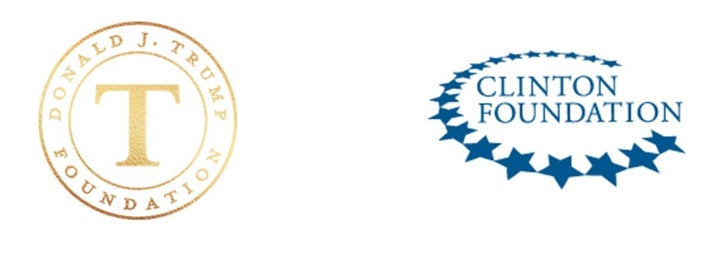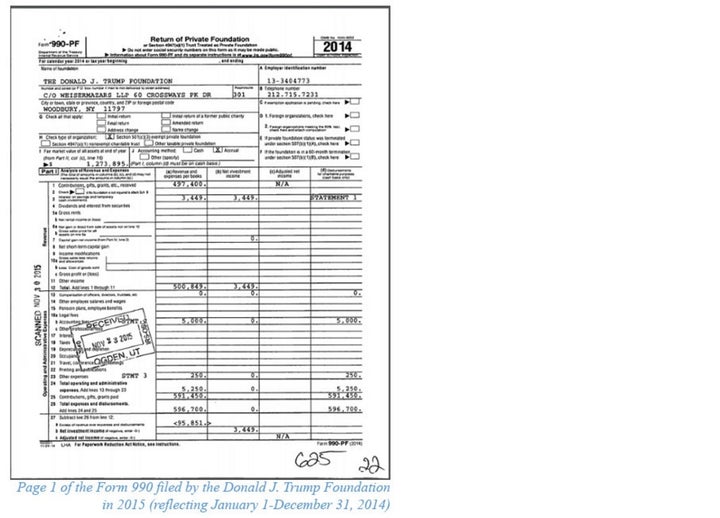
Nonprofits are a cornerstone of American democracy. They reflect the political diversity of the American people. That diversity is well illustrated by two institutions currently in the news: the Bill, Hillary and Chelsea Clinton Foundation and the Donald J. Trump Foundation.
GuideStar takes no position on elections, and we will not comment on Hillary Clinton or Donald Trump as candidates for the presidency. We have, however, been repeatedly asked about the Trump and Clinton Foundations. Accordingly, we would like to offer a few notes of analysis on their structure, size, strategy, and transparency practices.

Structure
Let us begin with a comparison of the basic facts. The Trump Foundation is legally categorized as a “private non-operating foundation” whereas the Clinton Foundation is a “public charity.” In simple terms that means the Trump Foundation is meant primarily as a vehicle for distributing grants from the Trump family fortune—although it also accepts funding from other donors. The Clinton Foundation is meant primarily as a vehicle for directly operating programs for the social good—while also making some grants to other organizations.
Despite these differences, both organizations are, in a (non-legal) sense, “celebrity foundations.” They are seeded by money donated by their founders and also serve as a vehicle for members of the public to demonstrate their support of a prominent person. At their worst, celebrity foundations are vanity projects with negligible impact. At their best, such organizations channel fragmented resources and yield extraordinary impact for society. For example, the Michael J. Fox Foundation is known as one of the most sophisticated players in the fight against Parkinson’s Disease.
Both the Trump Foundation and the Clinton Foundation are filed under section 501(c)(3) of the U.S. tax code, meaning they legally cannot engage in electoral activity. In general, they appear to have followed this requirement. There is at least one exception, though. The Trump Foundation made one donation to a political action committee associated with Florida Attorney General Bondi. It is not legal for a foundation to make a donation to a PAC; the Trump Foundation has paid a $2,500 IRS fine for this infraction. The Trump Foundation characterized this as a clerical error although others have described it as a case of “pay-to-play politics.” At the very least, this incident indicates insufficient controls and lax managerial oversight.
Size
One thing is indisputable: The Clinton Foundation is far larger than the Trump Foundation. The latest comparable data from December 31st, 2014 shows the Clinton Foundation with assets of $354 million, compared with the Trump Foundation’s $1 million. The Clinton Foundation had total expenses of $91,281,145, versus $596,450 for the Trump Foundation. The Clinton Foundation had 486 staff compared to zero staff at the Trump Foundation.
The Clinton family’s tax returns suggest that the majority of its charitable giving has been through the Clinton Foundation. Without access to Mr. Trump’s tax forms, it is difficult to know the scale of his charitable activities outside the Trump Foundation. But it does appear that the dollars have not matched the pledges.
An investigation by the Washington Post has not been able to validate that Trump has actually donated the money he pledged, instead finding, “Trump promised millions to charity. We found less than $10,000 over 7 years.” In addition, the last donation to the Trump Foundation by any of its trustees—family or otherwise—was in 2008. Indeed, David Farhenthold of the Post has suggested that the Trump Foundation has transformed over the last decade from “standard-issue rich person’s philanthropy into a charity that allowed a rich man to be philanthropic for free.”
All told, the data at hand would suggest that the Clinton family has—at least over the last several years—donated more money (and at a far higher proportion of their wealth) than the Trump family.
Similarly, it appears clear that the Clintons have out-raised Trump. The Clintons’ fundraising for their foundation is one aspect of a broader fundraising portfolio totaling $3 billion over the last four decades. This is a remarkable number but they are not alone operating at this level: the Bush family raised $2.4 billion over a similar period. Trump has certainly helped raise money for both charitable and electoral efforts, but the total is undoubtedly less than the Clintons’.
Fundraising at this scale takes place in a rarefied social circle. Each of these families—the Clintons, the Bushes, and the Trumps—must navigate a tangle of relationships with wealthy individuals. These relationships have caused some to claim that fundraising for the Clinton Foundation compromised Clinton’s role as Secretary of State. There appears, though, to be little evidence to support this claim. The Clinton Foundation signed an MOU in 2008 clarifying that Hillary Clinton would not have a role with the Foundation during her tenure at the State Department. And, indeed, funding for the Clinton Foundation decreased significantly during that period (2009-2013). A fair argument can be made that the Clinton Foundation should have been more aggressive in dealing with the perception of potential conflict. To its credit, the foundation now proactively shares its key legal and audit documentation and has built a tool on its website to provide an additional layer of transparency about its donors (including both Donald and Ivanka Trump).

Transparency and Strategy
Transparency is not a guarantee of effectiveness—but, in general, we believe that transparency is correlated with excellence in nonprofits. Transparency indicates an openness to questions and accountability. And, importantly, the act of transparency can force an organization to be clear about its goals and strategy.
Most nonprofits—including the Trump and Clinton Foundations—are required by law to file a regulatory document with the IRS, the Form 990. The 990 provides important baseline information but does not give a full view of the nuances of nonprofit work. Accordingly, GuideStar invites nonprofits and foundations to share additional data. Approximately 128,000 have done so. Some 34,997 organizations have provided enough to get one of GuideStar’s four “transparency seals”; of those, 1,061 have earned the highest level, Platinum. The Clinton Foundation is one of them. The Trump Foundation has provided no additional information and so has not earned a transparency seal.
As a part of achieving a Platinum seal, the Clinton Foundation has provided a set of quantitative metrics about its programs. For example, one metric, “number of farmers benefitting from access to improved agricultural practices, increased yields, and enhanced market access,” rose from 66,124 in 2014 to 114,825 in 2015. Another, the “number of girls and women provided access to job skills training and livelihood support,” rose from 35,587 in 2014 to 48,696 in 2015. The fact that the Clinton Foundation provides such metrics makes it far easier for donors and citizens to meaningfully analyze the institution’s value to society.
The Trump Foundation provides no such metrics. Any analysis must therefore be based on the content of publicly available tax forms. These forms appear to indicate an unfocused generosity. For example, the below sample from the Trump Foundation’s 2014 tax return includes grants to the Orthopaedic Foundation, the Palm Beach Opera, the Police Athletic League, Protect our Winters, and the Ronald McDonald House of New York. There is nothing inherently wrong with sprinkling many small grants in unrelated areas. But the Trump Foundation’s approach would certainly not meet the standard of focused, proactive grantmaking commonly called “strategic philanthropy.”

Conclusion
Both the Clinton and Trump Foundations have been the subject of controversy while seeking to contribute to social good. They are undoubtedly different from each other in size, structure and openness. Indeed, the two organizations reflect the perceived styles of the two candidates: one systematized, the other improvisational. Donors regularly decide which approach they prefer for their giving. Later this year, voters will decide which approach they prefer for their leadership.
Notes
The data on the two foundations’ sizes comes from the Forms 990 filed by the two foundations in 2015 reflecting the period from January 1-December 31, 2014. Because the Trump Foundation is categorized as a private non-operating foundation, it files a Form 990-PF. As a public charity, the Clinton Foundation files a 990.
The Donald J. Trump Foundation is not to be confused with the Israel-based Trump Foundation or the Eric Trump Foundation.
The majority of organizations with transparency seals on GuideStar do direct service in their communities. But many policy and advocacy organizations across the political spectrum also share additional data, including the Heritage Foundation (Platinum) or the ACLU Foundation (Gold).
GuideStar’s data comes from three primary sources, including the IRS Form 990 that most nonprofits are required to file. We have posted and digitized millions of 990s.
Data about individual political contributions above $250 by American citizens can be found at www.opensecrets.org.
Further sources:
- Richard W. Painter, “The Real Clinton Foundation Revelation,” The New York Times, August 31, 2016.
- Eugene Robinson, “Hillary Clinton must learn from her mistakes,” The Washington Post, August 29, 2016.
- Jim Rutenberg, “Trump is Testing the Norms of Objectivity in Journalism,” The New York Times, August 7, 2016.
- Ben Davis, “Donald Trump: The Least Charitable Billionaire In The World,” News Examiner, September 2015.
- Ruth McCambridge, “Clinton Foundation ‘Doles Out Funds to Friends’: Is There a “There” There?” Nonprofit Quarterly, May 16, 2016.
